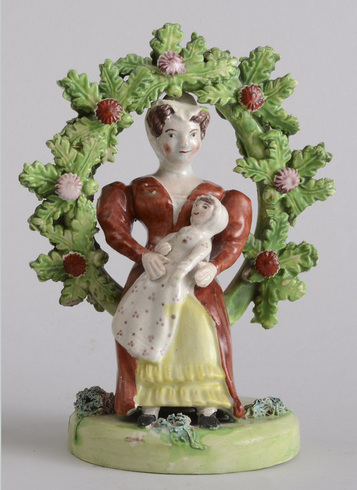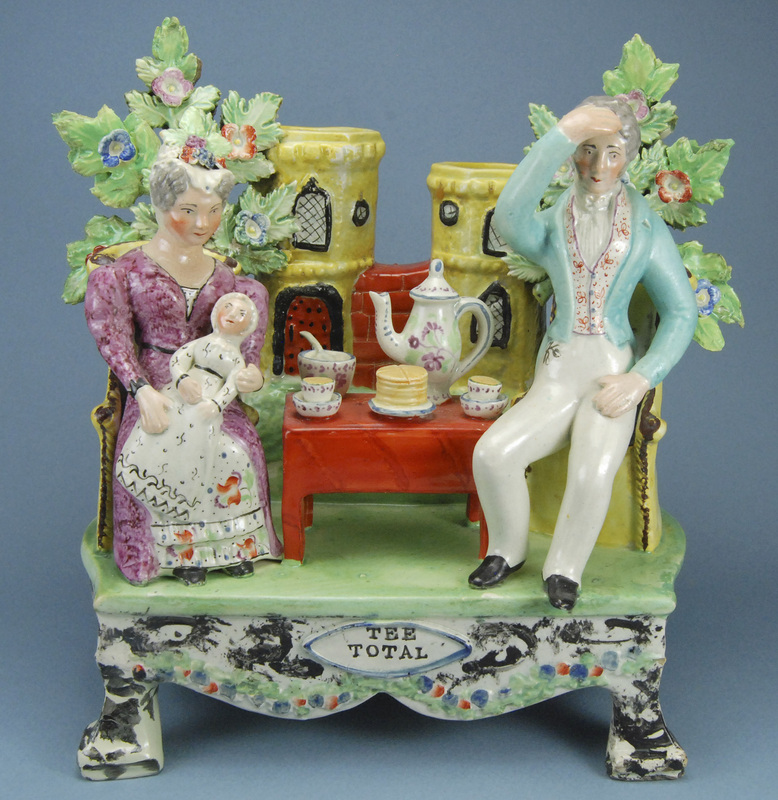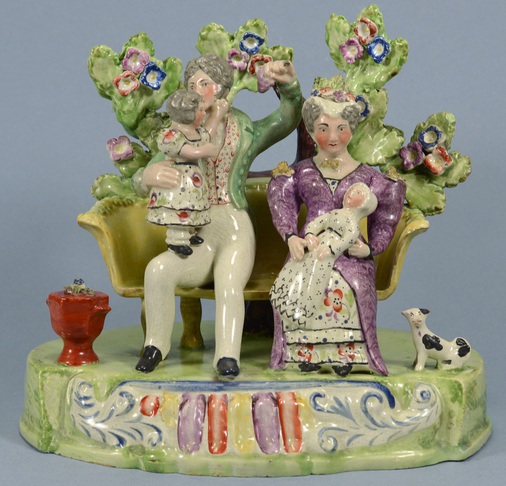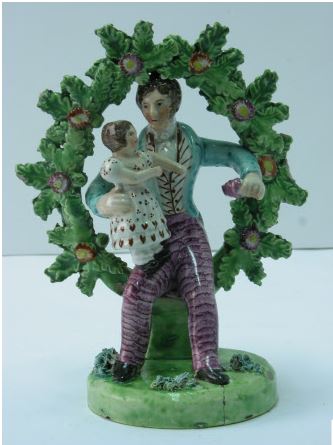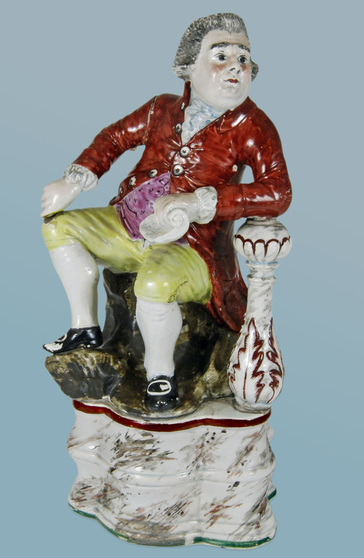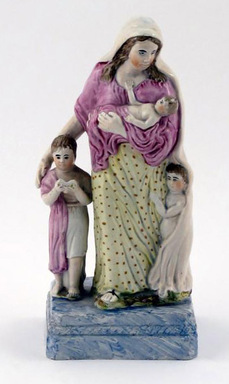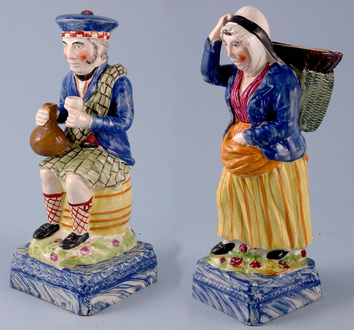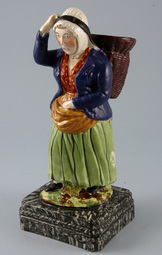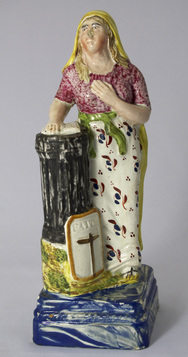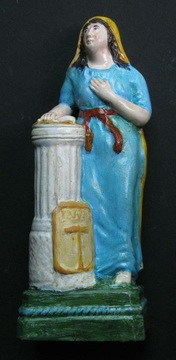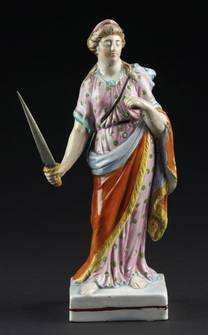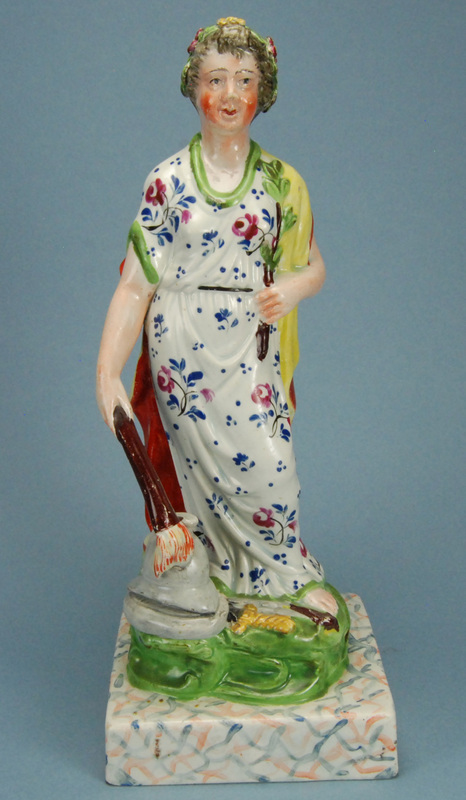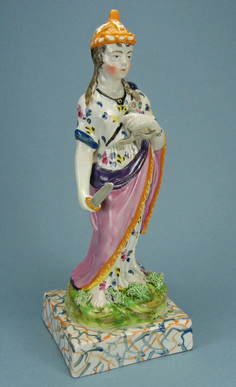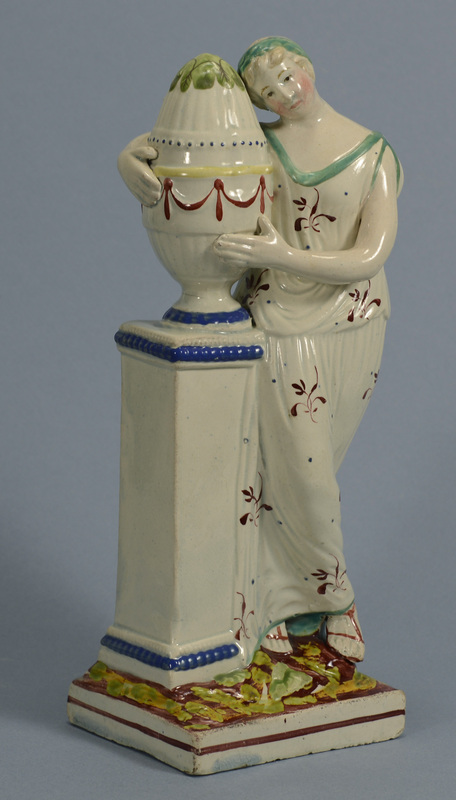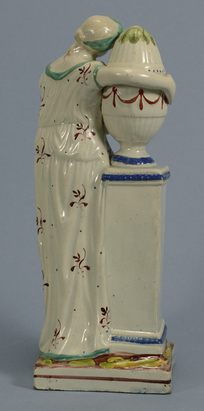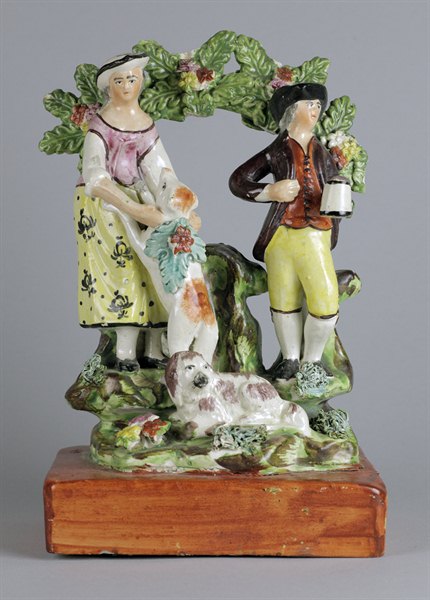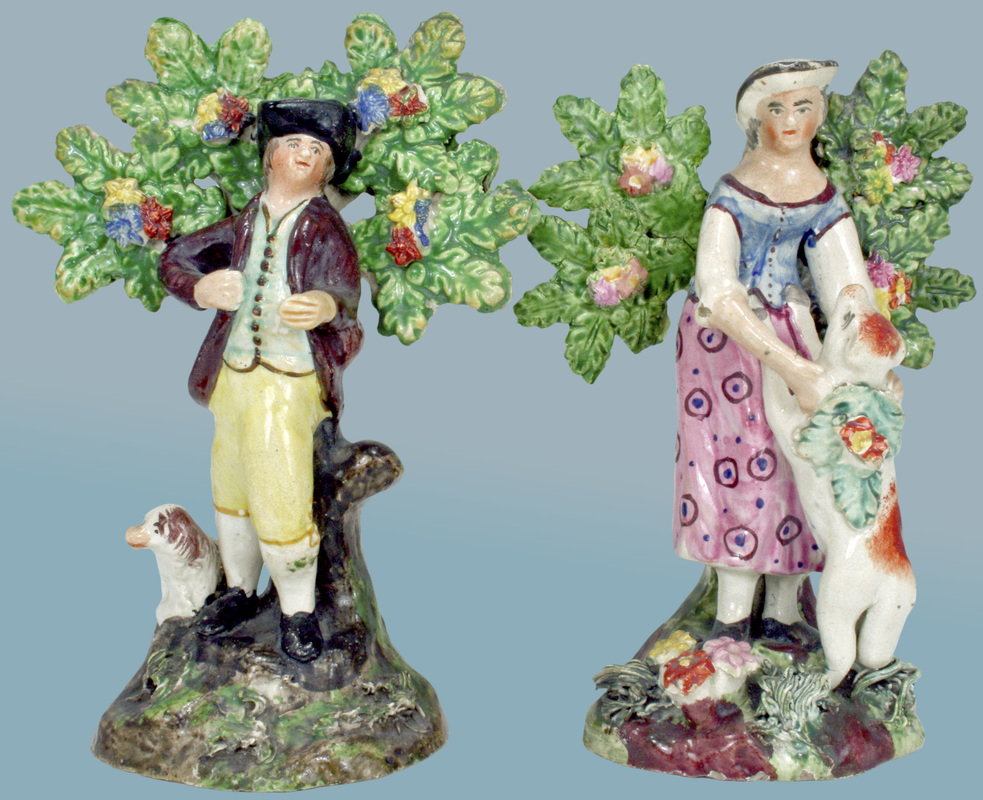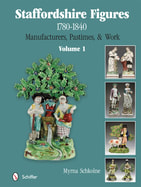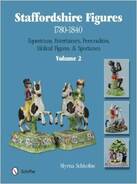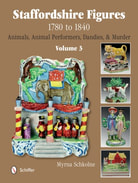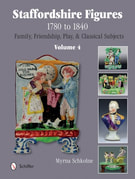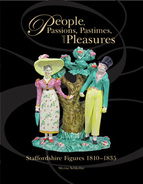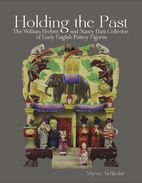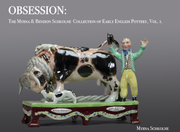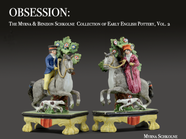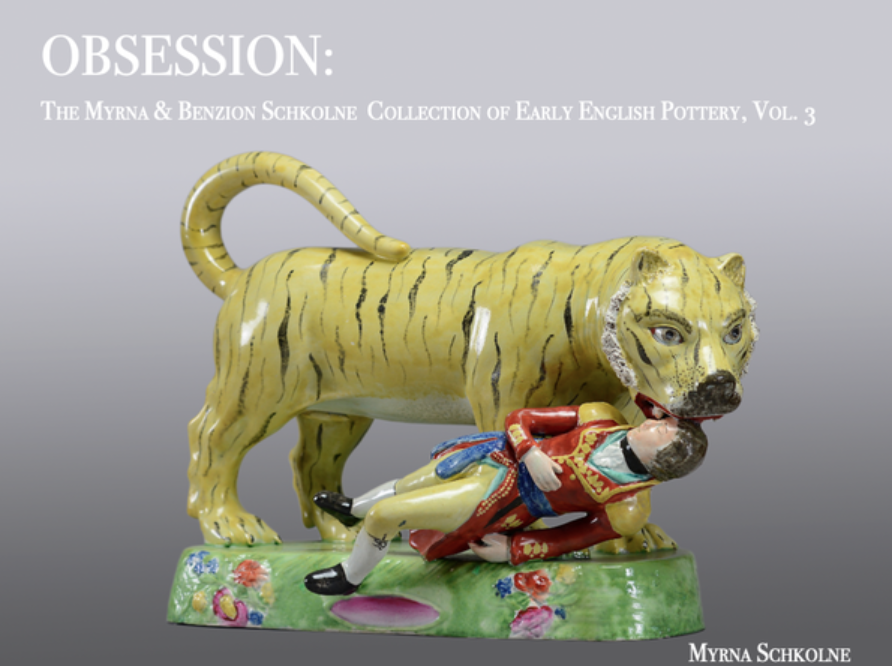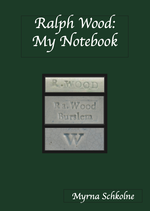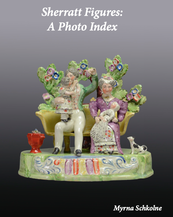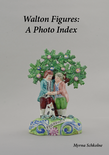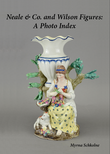|
Auctions are traps for the unwary or inexperienced, and so it was a few days ago. I was dismayed when silly money chased a pair of equestrians that I wouldn't have wanted---and yet a fabulous unrecorded figure group slipped by without any fanfare. This dazzling mother and child group is known from only this example. It is attributable to "Sherratt", but, it takes a little knowledge to pinpoint that. The decoration is certainly not particularly "Sherratty", and the bocage leaves are common enough. However these very bocage flowers and leaves occur in combination on other "Sherratt" figures. More importantly, the mother and child are from the same molds as were used in two other uniquely "Sherratt" groups: Tee Total groups, and Happy Family groups. You can see both below. I am always thrilled to learn of an unrecorded figure, but, of course, that doesn't happen very often. The mother-and-child group has a companion father-and-child group that I have yet to see in the flesh. It belongs to the National Trust and is tucked away in one of England's National Trust properties. Again, the father-and-child group is from the same molds as used in the "Sherratt" Happy Family group above. For me, collecting is as much about the hunt as the kill. I have known of the National Trust's father-and-child for a while, but learning about the companion mother-and-child model was simply the cherry on the top!
0 Comments
Saturday was a big day. A large box arrived on our doorstep mid-morning. In it was an advance copy of Staffordshire Figures 1780 - 1840, Volume 1, along with a bottle of wine. Thank you, Schiffer Publishing! At last, we collectors are on the path to having the reference books we need. Volumes 2, 3, and 4 will follow at six-month intervals, and if you have not ordered Volume 1 yet, do go ahead and take advantage of the early-order discounts that will surely vanish when the book is released at the end of November. Am I enjoying the book? Truth be told, I probably will not be able to open it for months. What if I were to find something I wish was otherwise? A baby, am I not? The new books are divided by subject matter. In Volume 2, due out in mid-2014, you will find figures of notable individuals. Among them is this gentleman. Any idea who he might be? The figure is in the Willett Collection, Brighton Museum, and it portrays John WIlkes (1726 - 1797). Wilkes was a great libertarian, so, appropriately, the scroll he holds is incised "The Rights of the People". Wilkes's life spanned both the French and American Revolutions, and his pursuit of liberty influenced the freedoms that Britons and Americans now enjoy. You can read about it on the Internet, but here are a few fascinating factoids about Wilkes:
The WIllett Collection figure of Wilkes was made circa 1790. By then, Wilkes had settled into a relatively staid old age. Given the complexity of the figure molds, I am not sure why more figure of Wilkes were not made. Perhaps they were, but today I know of only two. The second (below) is in a private collection. 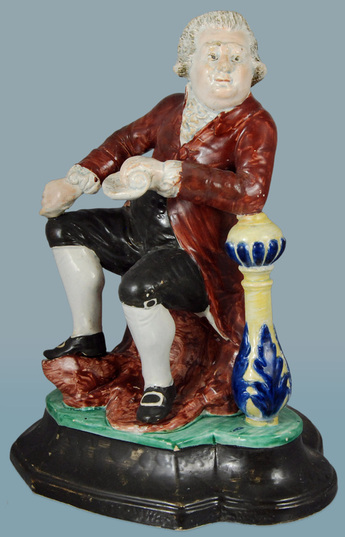 As you can see, the figure appears to come from the same figure molds as the Willett Collection figure, but the base is different. The scroll is again inscribed "The Rights of the People". Far from vanishing into the mists of time, WIlkes today remains quite relevant. In America, towns (Wilkesboro, North Carolina, and Wilkes-Barre Pennsylvania), counties (Wilkes County, Georgia, and Wilkes County, North Carolina), and Wilkes University are named for John Wilkes, as was John Wilkes Booth, President Lincoln’s assassin. 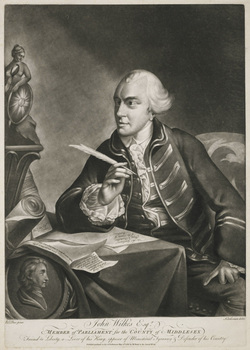 Assorted prints of Wilkes have survived the centuries, but what more life-like portrayal could there be than these two Staffordshire figures? Made when Wilkes was still alive, they give us engaging, life-like glimpses of one on the most important reformers of all time. To hold one is truly to touch the past. I have a particular penchant for figures of Charity and keep a number on a table in my office. Each represents the output of a different pot bank, so collectively they are a sample book of sorts. Recently, the figure below went to auction at Woolley & Wallis. The base in particular caught my attention. Bases of this sort are associated with the Scottish Potteries. Below, you see the same base form on a pair of typical Scottish figures formerly in the stock of Andrew Dando. I think they are superb. While you most customarily see this base painted blue, it also occurs painted in other colors. Below is the Scottish fisherwoman again, but this time with a black base, and again formerly in the stock of Andrew Dando. Figures of Charity were made as companions to figures of Faith and Hope. If I find an unusual example of one, I immediately start searching for her companion figures. The Charity that sold at Woolley & Wallis does indeed have companions. Below are figures of Faith on the same base in two quite different palettes. I am certain that I have seen Charity in this set too, but for the life of me I cannot find the picture. Very frustrating! The point is that not all the figures we think of as Staffordshire were made in Staffordshire or even in England. The vast majority were, but some were made in other places. Scotland's potters--some of whom no doubt acquired their expertise in Staffordshire--turned out similar wares, using clay from Ireland.
Do you know where the clay for Staffordshire figures came from? It is logical to think it came from Staffordshire. After all, wouldn't you assume that a pottery industry would develop in an area rich in clay? Well, the answer is not that simple. The clay in Staffordshire is heavy red clay that is not suited to making figures. The key ingredient that lies beneath the ground in Staffordshire is coal. Pottery manufacture required about 20 tons of coal for each ton of clay used, so it was more important to be near coal than near clay. Staffordshire potters imported their clay into their district from the south of England. This simply gorgeous figure of Peace was until recently in the stock of Nestegg Antiques. She sat there for a little while, awaiting her new home, because the market currently deems classical figures on square bases quite boring. Consequently, the price of this figure--like that of others of her ilk--was ridiculously low. To jolt your memory, Peace is torching the weapons of war at her feet. She has an olive leaf wreath atop her head, and she holds an olive branch in one hand. The early enamels on this figure are so soft and pleasing, and her face is beautiful. What more could you want? The companion figure to Peace is the lady below symbolizing Justice. She holds a sword (restored) in her one hand and the scales of justice are missing from her other. Her eyes are closed because Justice is supposed to be blind. This figure is in the collection of the Victoria and Albert Museum. You will have extraordinary difficulty finding a Justice in reasonable shape on the market or in private collections. Justice was once as readily available as Peace seems to be today--but Justice's arms are more vulnerable and perhaps, over time, breakage claimed many victims. Now to the same subjects with a very different look. The figure below left also portrays Peace, and Justice, the companion figure is on the right. Both figures have contemporary rather than classical features. I have recorded only one example of this Peace and two of this Justice. Look at Peace's very pretty face. Neither figure is after an ancient Roman. Rather, lovely English lasses were their inspiration. You may not be able to find the above figures of Peace and Justice on marbled bases, but you certainly can find a lovely Peace on a square base painted with a line--and many more other classical figures with similar bases. What's more, you can find stunningly good examples of these figures at ridiculously low prices. The figure below is yet another classical figure that was very inexpensive because the market deemed it "ordinary". Charlotte at the Tomb of Werther is the subject. To jog your memory, The Sorrows of Young Werther, a German novella by Johann Wolfgang von Goethe published in 1774, tells of Werther, who kills himself when he cannot have Charlotte, the woman he loves. Although Charlotte buries Werther under a linden tree and there is no mention of ashes, figures portray Charlotte clutching a funeral urn. Figures like this may be inexpensive now, but it won't always be so. It takes just a little looking to find a great example, but it can be done with relatively little time and money. At the end of the day, you will have a 200-year old figure that exudes charm and beauty. What more could you want?
A word of caution: I have noted over-priced (and often wrongly described) Staffordshire figures being sold by dealers who do not specialize in early Staffordshire. Be VERY cautious when shopping at an antiques mall (brick-and- mortar or in cyberspace.) And another word of caution: when buying "ordinary" figures, maintain a high standard. Don't tolerate restoration. And be sure to look for a nice glaze (minimal wear and crazing) and pretty enamels. Last week, this unusual figure group changed hands. A shepherd and shepherdess are common enough (or should I say "were" because everything is so scarce now), but to see common-or-garden shepherd and shepherdess figures on ONE base is extremely unusual. In fact, I can't recall another enamel-painted figure group modeled in that way. I am always suspicious of anything that is irregular. The red flags go up. "Trust but verify", the motto of former US President Ronald Reagan, is something we collectors should all practice. But in this case, I knew the figure group was right. The reason for my confidence is that I instantly recognized certain distinctive features as belonging together: that bocage and its flowers, that dog, and the sheep with a leaf on its back. Below you see them as separate figures. As you see, the bocage is quite specific in form, as is the dog. And the sheep has a bocage leaf on its back. These features all tie the pair of figures to the group that just sold. Clearly, they were all made by the same unknown pot bank. The shepherd in the group has a restored hand. Someone restored it to hold a tankard, and this can and should be redone.
I have been criticized for my obsession with detail. Some claim it doesn't matter and all that counts is that the figure be lovely. But knowing the details has enormous value. In this case, it helped confirm that the group offered on eBay was correct. As I said, this extraordinary little gem came up on eBay with a Buy It Now. Somebody (presumably with knowledge) acted very quickly and bought it, and I suspect others looked but were uncertain. The picture of the pair of shepherds is in Volume 1 of my new book, due out in November. How I wish I could add the eBay group, but too late. In any event, all the pictures in my book will help all of us learn--or at least those of us who know the fine points matter. I know I am always waiving the Red Alert flag on eBay, so how come this time somebody got lucky? Well there is a first time for everything. A few months ago, it even snowed in Cape Town, South Africa for the very first time! I continue warning about buying from random small sellers on eBay--or anywhere for that matter--but arm yourself with knowledge, and you can venture further. Don't just buy my book. Buy every book and old catalog you can lay your hands on. Knowledge truly is power in this game. So before you rush off to see what you can find on eBay, let me warn yet again. I occasionally buy on eBay, but in nearly every case I return the figure because of undisclosed restoration. Currently, a figure that has lost its base is on eBay, but it takes some expertise to know this....and the bids keep going up and up. Recently, a new collector bought a small figure on eBay. It was one of those sales where you make an offer, and this time the "offers" escalated very quickly. I suspect something fishy was going on--and the collector ended up paying about $2,000 for a mis-described figure with issues--when a perfect example changed hands a short while before from a dealer's stock for around $600. If you don't have enormous expertise, please buy from a reputable dealer and you won't live to regret it. |
Archives
September 2023
All material on this website is protected by copyright law. You may link to this site from your site, but please contact Myrna if you wish to reproduce any of this material elsewhere. |
